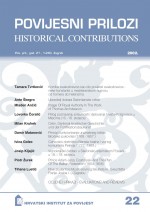Komika svakodnevice kao dio povijesti svakodnevice - neke konstante u mediteranskom humoru od Homera do danas
The Comicality Of The Quotidian As A Part Of The Comicality Of History - Some Constant Features Of Mediterranean Humour from Homer until Today
Author(s): Tamara TvrtkovićSubject(s): History
Published by: Hrvatski institut za povijest
Summary/Abstract: The phenomenon of the comical aspects of the quotidian could have been approached in two ways: on the one hand, the genres of classical literature in which the phenomenon appears had to be researched and the one that lends itself most easily to investigation selected among them; on the other, the term ‘the comicality of the quotidian’ itself had to be defined and the criteria devised which would enable a classification of the devices by means of which the humorous is achieved. In an attempt to define the terms ‘comical’ and ‘humorous’ as simply as possible, one could say that “all that causes laughter and appears in actual life situations” is humorous, whereas the comical is “the humorous actualised as a dimension of the aesthetic experience.” The humorous aspects of the quotidian, as a part of everyday life, would thus be a disruption of the commonly acknowledged harmony and order that is accepted by the majority in a community and repeated day in, day out. Turning ‘the humour of the quotidian’ into a literary form and communication act creates ‘the comicality of the quotidian’. The beginnings of the literary fashioning of the comical are found already in Homer, while comedy, lyric poetry, mime, satire, literary joke (Witz) and the skoptic epigram are some of the classical forms in which the elements of the comical can be identified. The development of the theory of the comical parallels the appearance of the comical in literature, and a comparison of the preserved texts of both groups reveals elements they have in common, but also points out some “illogicalities”, as we shall try to show. The Hellenistic collection of apophthegms and jokes known as the Philogelos has been used as a model of classification, as the jokes included in it are the sole source for exploring the aetiology and development of authentic “everyday” jokes in classical antiquity. By means of an analysis of examples, based in part on the criteria of the theoreticians Propp and Bergson and in part on the structuralist discussions of the communication act, the conclusion is reached that there exist certain constant features of the comical from Homer’s time to the Hellenic era, and even to our own days (provided, of course, one stays within the Mediterranean context). The resemblance’s are to be found in the model of structuring, the ways in which the comic effect is achieved (comedy of characters, comedy of situations, and comedy of words), and the similarity of motifs. Apart from this, there can be noted a certain similarity in the ways previous and modern times conceive of the comprehend the world, so that some of the comic situations from classical antiquity can be understood without further explications.
Journal: Povijesni prilozi
- Issue Year: 2002
- Issue No: 22
- Page Range: 7-17
- Page Count: 11
- Language: Croatian

